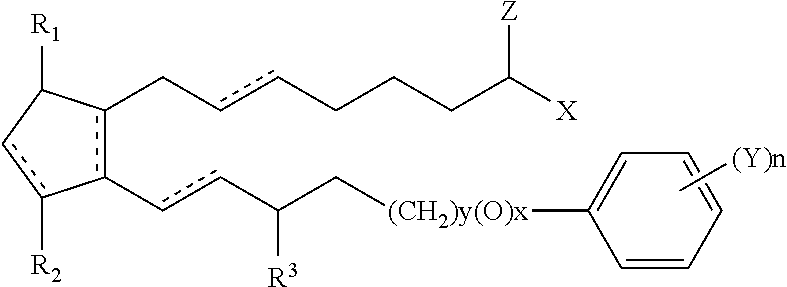Hypotensive lipid-containing biodegradable intraocular implants and related implants
a biodegradable, intraocular technology, applied in the field of eye treatment, can solve the problems of affecting the clinical potential of prostaglandins in the management of conditions associated with increased ocular pressure, e.g. glaucoma, greatly limited by these side effects, and achieves the effects of reducing ocular hypertension, reducing at least one symptom of an ocular condition, and increasing intraocular pressur
- Summary
- Abstract
- Description
- Claims
- Application Information
AI Technical Summary
Benefits of technology
Problems solved by technology
Method used
Image
Examples
example 2
Extrusion Process and Compression of Manufacturing Bimatoprost-Containing Biodegradable Intraocular Implants
[0131]Bimatoprost is combined with a biodegradable polymer composition in a mortar. The combination is mixed with a shaker set at about 96 RPM for about 15 minutes. The powder blend is scraped off the wall of the mortar and is then remixed for an additional 15 minutes. The mixed powder blend is heated to a semi-molten state at specified temperature for a total of 30 minutes, forming a polymer / drug melt.
[0132]Rods are manufactured by pelletizing the polymer / drug melt using a 9 gauge polytetrafluoroethylene (PTFE) tubing, loading the pellet into the barrel and extruding the material at the specified core extrusion temperature into filaments. The filaments are then cut into about 1 mg size implants or drug delivery systems. The rods may have dimensions of about 2 mm long×0.72 mm diameter. The rod implants weigh between about 900 μg and 1100 μg.
[0133]Wafers are formed by flattenin...
example 3
Bimatoprost / PLA / PLGA Intraocular Implants to Treat Glaucoma
[0138]A 72 year old female suffering from glaucoma in both eyes receives an intraocular implant containing bimatoprost and a combination of a PLA and PLGA in each eye. The implants weigh about 1 mg, and contain about 500 mg of bimatoprost. One implant is placed in the vitreous of each eye using a syringe. In about two days, the patient reports a substantial relief in ocular comfort. Examination reveals that the intraocular pressure has decreased, the average intraocular pressure measured at 8:00 AM has decreased from 28 mm Hg to 14.3 mm Hg. The patient is monitored monthly for about 6 months. Intraocular pressure levels remain below 15 mm Hg for six months, and the patient reports reduced ocular discomfort.
example 4
Bimatoprost / PLA Intraocular Implants to Reduce Ocular Hypertension
[0139]A 62 year old male presents with an intraocular pressure in his left eye of 33 mm Hg. An implant containing 400 mg of bimatoprost and 600 mg of PLA is inserted into the vitreous of the left eye using a trocar. The patient's intraocular pressure is monitored daily for one week, and then monthly thereafter. One day after implantation, the intraocular pressure is reduced to 18 mm Hg. By day 7 after implantation, the intraocular pressure is relatively stable at 14 mm Hg. The patient does not experience any further signs of elevated intraocular pressure for 2 years.
PUM
| Property | Measurement | Unit |
|---|---|---|
| time | aaaaa | aaaaa |
| time | aaaaa | aaaaa |
| size | aaaaa | aaaaa |
Abstract
Description
Claims
Application Information
 Login to View More
Login to View More - R&D
- Intellectual Property
- Life Sciences
- Materials
- Tech Scout
- Unparalleled Data Quality
- Higher Quality Content
- 60% Fewer Hallucinations
Browse by: Latest US Patents, China's latest patents, Technical Efficacy Thesaurus, Application Domain, Technology Topic, Popular Technical Reports.
© 2025 PatSnap. All rights reserved.Legal|Privacy policy|Modern Slavery Act Transparency Statement|Sitemap|About US| Contact US: help@patsnap.com



